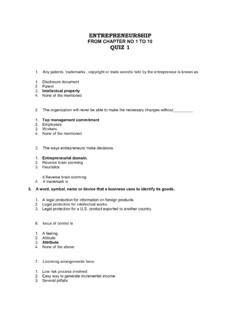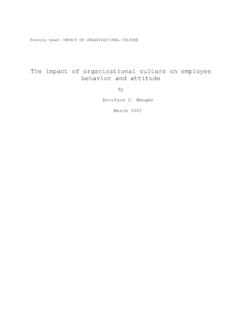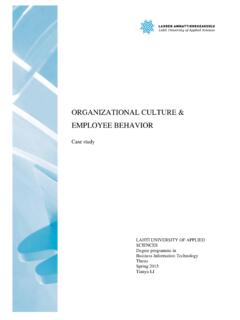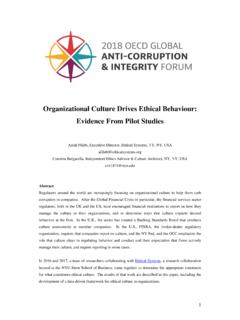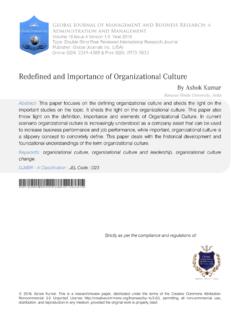Transcription of MGT502 Organizational Behavior All in One Solved MCQs
1 Page MGT502 Organizational Behavior All in One Solved MCQs 1) The belief that "discrimination is wrong" is a value statement. Such an opinion is the _____ component of an attitude. cognitive affective reactive behavioral Ref: The belief that "discrimination is wrong" is an example of the cognitive component of an attitude. 2) Leon Festinger would propose that the desire to reduce dissonance would be determined by all of the following EXCEPT _____. the importance of the elements creating the dissonance. the degree of influence the individual believes he or she has over the elements. the rewards that may be involved in dissonance. the extent to which attitudes are widely held by society.
2 Ref: According to Leon Festinger's theory of cognitive dissonance, the desire to reduce dissonance would be determined by the importance of the elements creating the dissonance, the degree of influence the individual believes he or she has over the elements, and the rewards that may be involved in dissonance 3) If attitudes and Behavior are inconsistent, individuals will most likely _____. change their Behavior change their attitudes Page change either their attitudes or Behavior do nothing Ref: When experiencing cognitive dissonance, one can change the Behavior , change the attitude, or decide that the Behavior is not important after all. 4) _____ describes a positive feeling about your job resulting from an evaluation of its characteristics.
3 Enlargement satisfaction engagement involvement Ref: Job satisfaction describes a positive feeling about your job resulting from an evaluation of its characteristics. 5) Job _____ measures the degree to which a person identifies psychologically with his or her job and considers his or her perceived performance level important to self-worth. commitment satisfaction involvement organization Ref: Job involvement measures the degree to which a person identifies psychologically with his or her job and considers his or her perceived performance level important to self-worth. Employees with a high level of job involvement strongly identify with and really care about the kind of work that they do.
4 Page 6) _____ commitment refers to an employee 's obligation to remain with an organization for moral or ethical reasons. Affective Continuance Theoretical Normative Ref: Normative commitment refers to an employee 's obligation to remain with an organization for moral or ethical reasons. For example, an employee who is spearheading a new initiative might remain with an employer because he feels it would negatively impact his employer if he left. 7) _____ refers to an individual's involvement with, satisfaction with, and enthusiasm for the work she does. employee engagement Normative commitment Cognitive support Job enrichment Ref: employee engagement refers to an individual's involvement with, satisfaction with, and enthusiasm for the work she does.
5 A recent study of nearly 8,000 business units in 36 companies found that business units whose employees had high-average levels of engagement had higher levels of customer satisfaction, were more productive, had higher profits, and had lower levels of turnover and accidents. 8) People with positive _____ believe in their inner worth and basic competence. Locus of control Page Self-monitoring Behavior Core self-evaluations Levels of enrichment Ref: People with positive core self-evaluations believe in their inner worth and basic competence. They are more satisfied with their jobs than those with negative core self- evaluations. 9) Quietly continuing to do your work, even though you're dissatisfied, is an example of _____ response to dissatisfaction.
6 Exit voice loyalty neglect Ref: Loyalty is passively but optimistically waiting for conditions to improve, including speaking up for the organization in the face of external criticism and trusting the organization and its management to "do the right thing". 10) Steve is unhappy with his job. He takes every possible vacation and sick day and sometimes shows up for work late. He is expressing his dissatisfaction with a _____. response. exit voice loyalty neglect Ref: Neglect is passively allowing conditions to worsen, including chronic absenteeism or lateness, reduced effort, and increased error rate. Page 11) Which of the following is NOT a characteristic of physical ability?
7 Stamina Strength Looks Dexterity Ref: Nine basic physical abilities are dynamic strength, trunk strength, static strength, explosive strength, extent flexibility, dynamic flexibility, body coordination, balance, and stamina. 12) The relationship between _____ and job performance is likely to be an issue of growing importance during the next decade. gender marital status age tenure Ref: The relationship between age and job performance is likely to be an issue of increasing importance during the next decade. Workers 55 and older are currently the fastest-growing sector of the labor force. In addition, federal legislation has outlawed mandatory retirement at the age of 70.
8 13) According to your text, which is the most likely explanation for the higher absentee rate for women? Women tend to have more illnesses that keep them from work than do men. Traditionally, women have had the responsibility of caring for home and family. Women tend to be less satisfied with their jobs than men and are consequently absent more often. Women generally have jobs for which a temporary replacement can be hired so absences are more permissible. Page Ref: Most research on women's absenteeism rates has been conducted in North America and North American culture has historically placed home responsibilities with women. Traditionally, women have had the responsibility of caring for home and family.
9 14) _____ is the learning concept of reinforcing closer and closer approximations to the desired new Behavior . Modeling Shaping Classical conditioning Social learning Ref: We shape Behavior by systematically reinforcing each successive step that moves the individual closer to the desired response. 15) An example of _____ is when an employee receives a one-week suspension from work and is fined $200 for stealing company property. penalization punishment extinction negative reinforcement Ref: Punishment is causing an unpleasant condition in an attempt to eliminate an undesirable Behavior . 16) Eliminating any reinforcement that is maintaining an unwanted Behavior is called _____.
10 Page extinction punishment negative reinforcement positive reinforcement Ref: Eliminating any reinforcement that is maintaining a Behavior is called extinction. When a Behavior is not reinforced, it tends to gradually be extinguished. 17) All of the following are TRUE about both positive and negative reinforcement EXCEPT: Both positive and negative reinforcement result in learning. Both positive and negative reinforcement strengthen a response. Both positive and negative reinforcement tend to weaken Behavior and decrease it subsequent frequency. Both positive and negative reinforcement increase the probability of repetition. Ref: Positive and negative reinforcement result in learning, strengthening a response and increasing the probability of repetition, while punishment and extinction weaken Behavior and tend to decrease its subsequent frequency.
